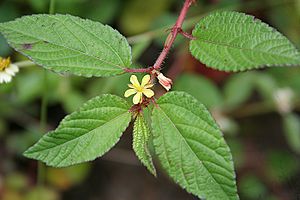Corchorus facts for kids
Corchorus is a group of flowering plants found in warm, tropical, and subtropical parts of the world. There are about 40 to 100 different kinds, or species, of Corchorus plants. These plants are known by different names depending on how they are used. For example, the strong fibers from these plants are called jute. The leaves, when used as a vegetable, are often called jute mallow leaves.
Contents
What Are Corchorus Plants Like?
These plants are usually tall, growing 2 to 4 meters (about 6 to 13 feet) high. They are mostly annuals, meaning they live for one growing season. Their leaves are long and narrow, about 5 to 15 centimeters (2 to 6 inches) long, with jagged edges. The flowers are small and yellow, with five petals. After the flowers, they produce a fruit that looks like a capsule and holds many seeds.
How Are Corchorus Plants Used?
Corchorus plants are very useful! People use them for their strong fibers and as a healthy food.
Fiber: Jute
The fibers from Corchorus plants are known as jute. Jute is one of the most widely grown vegetable fibers in the world, second only to cotton. It's used to make things like rope, burlap, and strong fabrics.
Food: Jute Mallow Leaves
The leaves of Corchorus plants are eaten in many countries around the world. Two main types, Corchorus olitorius and Corchorus capsularis, are popular.
When cooked, the leaves can feel a bit "slimy," similar to okra. This is because they contain a special substance called mucilage. The seeds can be used for flavor, and a herbal tea can be made from the dried leaves.
Corchorus leaves are packed with good things for your body! They are rich in betacarotene (which your body turns into vitamin A), iron, calcium, and vitamin C. They also have antioxidants, which help protect your body's cells.
Corchorus in Different Cuisines
- In North Africa and the Middle East, the young leaves are called malukhiyah in Arabic. They are a popular green leafy vegetable. Malukhiyah is eaten a lot in Egypt and is even considered the Egyptian national dish by some. It's also found in the foods of Lebanon, Palestine, Syria, Jordan, and Tunisia. In Turkey and Cyprus, it's called molohiya and is often cooked in a chicken stew.
- In Nigeria, the leaves are used in a stew called ewedu. This stew is often eaten with other starchy foods like amala. In Northern Nigeria, it's known as Ayoyo and used to make a sauce called Miyan Ayoyo.
- In Ghana, people in the North eat it as ayoyo, usually with Tuo Zaafi (a food made from cornflour).
- In Sierra Leone, it's called krain krain and cooked as a stew, often eaten with rice or foofoo (a traditional food made from cassava).
- The Luhya people of Western Kenya call it mrenda or murere. They eat it with starchy foods like ugali.
- In Northern Sudan, it's called khudra, which means "green" in Sudanese Arabic.
- The Songhai people of Mali call it fakohoy.
- In India, it's known as nalta sag. It's a favorite summer food, especially in parts of Odisha. It's often lightly cooked and eaten with rice.
- In the Philippines, C. olitorius is called saluyot. It's commonly eaten as a leafy vegetable, sometimes with bamboo shoots.
- In Thai cuisine, the leaves of Corchorus olitorius are called bai po. They are eaten cooked, often with plain rice congee. They taste similar to spinach.
See also
 In Spanish: Corchorus para niños
In Spanish: Corchorus para niños




